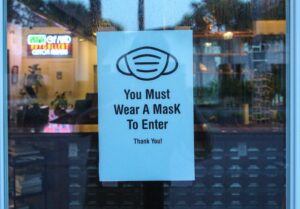An article in the Spanish newspaper El Pais (published in October 2020) got us thinking about the different ways interior design can help slow or stop the spread of coronavirus in indoor spaces. The piece provides graphics that show how aerosol droplets containing the virus circulate around different rooms – a normal-sized room in a house, a bar or restaurant and a school classroom.
As interior designers working with independent restaurants and cafés the scenario based around a bar or restaurant was the most fascinating for us. Because of the numbers of people in these spaces they also have the potential to be the most virulent spreaders of the virus, which means we need to pay extra attention to the ways we use the space safely.

How can this research inform interior design?
In this study the first example was a bar with just 18 people but no mechanical ventilation and all windows closed. If one of those people were infected then after four hours 14 of the other staff and customers could feasibly catch the virus from them if no measures were taken to mitigate the spread of aerosols. If masks were worn the number of possible new infections drops to 8 – still significant but markedly better. With good precautionary adaptations the risk of new infections falls dramatically to just one.
We thought we would add some of our design expertise to this research to show how you could incorporate its findings into plans for opening a Covid-safe restaurant space. Find out how clever, agile interior design could help reduce the spread of coronavirus:
-
Ventilation
The HSE requires businesses to ensure there is a good supply of fresh air in circulation, even before the Covid pandemic. Now it is significantly more crucial. By installing mechanical ventilation, like an air conditioning unit, you can reduce the concentration of aerosols in the air. Opening windows is also effective in improving air flow and reducing risk. But obviously this must not be at the expense of customers’ comfort – you don’t want people shivering into their dinners!

Look at your space and identify any areas that have poor ventilation. Add an air con unit and make sure you regularly wholly refresh the air in the entire space. You can do this between sittings or build in a buffer to booking times that allows for opening all windows and doors. Smaller spaces will need only a compact, mobile air filter or air conditioning unit. The benefit of these are they can be moved around a room or venue to clean the air throughout. Evaluate the way your space is currently used and identify the optimum space for a mobile unit where it won’t be obvious or obstructive, but can still work effectively. This might mean moving tables and seating.
To ensure effective protection against Covid and other virus aerosols you could install a high-energy efficiency air filter that can either be a standalone unit or fitted to your existing ventilation and heating system. Locate the optimum position in your venue for a unit, and ensure it is quiet enough to be discreet.
Fans are useful but only where there is effective natural ventilation.
-
Reducing time at the bar/ counter
Implement innovative ways to take orders using new technologies that enable customer to order when they book or remotely through their mobile phones. This means there’s no need to mingle or queue near the counter or bar.
-
Wearing masks when moving around the space

When customers and staff need to move between tables and the toilets or kitchen, make sure they are clearly required to wear masks. Create clear signs stating this requirement and place them in prominent positions, including outside the entrance.
-
Maintain distancing through creating more circulation space
This ensures that fewer droplet (another way the virus is transmitted) pass between people in the room. By moving the furniture and fittings to enable a smooth, continuous flow around the space, you can reduce close contact between people. Decide where your staff need to move – usually from tables to and from the counter and kitchen – and encourage customers to flow around another area. Use subtle markers to indicate circulation directions, like cable lighting along a wall at a low level, or stylish floor markings.
This is undoubtedly a very challenging time for small businesses in the retail and catering sector. We are here to support you and give your establishment the best possible chance of succeeding and come through this crisis ready to thrive. Get in touch to find out more about how our work can help you.